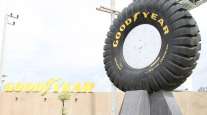Special to Transport Topics
Tire Maintenance Involves Familiar Practices, New Technology

[Stay on top of transportation news: Get TTNews in your inbox.]
Heavy-duty truck tire maintenance is proof positive that a field can remain constant while constantly evolving. Many parts of the tire-changing process have remained static for decades. But fleets say new tire designs, tools and technologies are enhancing maintenance operations, especially for tire monitoring.
“The tires have changed, very much so. But that doesn’t change the way we service them,” said Kevin Rohlwing, senior vice president of training at the Tire Industry Association. “The mounting and demounting of tires hasn’t really changed since I first did it in 1982.”
Fleets confirm that tire makers constantly release new compounds and designs, but generally, maintenance shops use similar techniques on modern and legacy models.

- Fleets implement techniques to fight corrosion from salts
- State DOTs find alternative solutions to clearing roads
- Tire maintenance involves familiar practices, new technology
- Automated manual transmissions become industry's popular option
- Braswell: Keeping a solid ADAS foundation
- Freeze: Trucking is the line between other industries
“Overall, there hasn’t been a whole lot of change we’ve seen from a maintenance standpoint, except probably faster wear cycles with some of the new tire compounds,” said Paul Pettit, vice president of maintenance at Eagan, Minn.-based Dart Transit.
American Trucking Associations’ Technology & Maintenance Council does ongoing work to upgrade existing recommended practices and develop new ones based on the technological advances in tire design. The RPs help technicians better understand spec’ing, maintenance and troubleshooting methods for all versions, said Jack Legler, technical director for TMC. “Wheels evolve in parallel with tires and include aerodynamic devices, along with tire pressure and condition sensors, monitoring and management.”
TMC’s largest section of RPs falls under the S.2 Tire and Wheel Study Group and its task forces. The Future Truck Committee’s Tire Durability and Reliability Task Force, for example, brings together fleets and manufacturers for collaborative work on identifying and reducing problems that limit tire durability and reliability, toward the goal of lowering tire operating costs in future designs.
Tire inventories are a significant financial investment, Legler said, and TMC helps fleets protect that investment with RPs for understanding and maintaining the inventory. New technologies make tire inventory tracking one of the most transformed truck tire-related topics in the past decade, sources said.
Inventory software stores details in a database for each of a fleet’s tires. It assists employees with quickly locating the proper tire on-site, assessing maintenance needs for tires on the road and determining replacement cycles. Tires with RFID tags or other embedded chips can be integrated into the systems to ease data transfer. Software capabilities vary, but modern systems tend to track tire conditions and performance in real time or nearly real time.
Mobile apps increasingly are being rolled into the tire monitoring mix. For example, Mount Sterling, Ill.-based Dot Foods works with a vendor whose app records data such as tire tread depths and PSI.
Monitoring software frequently is used in conjunction with on-truck tire pressure technology, another area that has experienced notable development in the last decade. Tire pressure monitoring systems and automatic tire inflation systems are a game changer for many fleets.
Sustaining a constant tire pressure and immediately addressing issues prevents failures, improves rolling resistance and decreases tread wear, all of which financially benefit fleets. Those that run automatic inflation systems on trailers experience “tremendous advantages” with improving earnings, labor efficiencies and safety, Rohlwing said.
Dart runs an ATIS on its trailers but not its tractors, which is common. Tire pressure monitoring products have been around for a couple of decades, but the technology has made it to the tractor side only in the last few years. “I think that’s the next frontier: some form of market penetration for TPMS and ATIS in the tractor market,” Rohlwing said.
More precise monitoring systems allow fleets to slightly alter their tire PSIs for optimal performance at each position on a truck. Dot Foods works with tire manufacturers to tweak some suggested PSIs at different tire positions and gauge performance versus previous benchmarks.

Buss
“That’s new for us. … But fuel economy always is a big deal with tires, and we watch that closely when making purchases,” said Kevin Buss, Dot Foods director of fleet maintenance. “Many folks that are not really familiar with tire programs would say they just need a tire that wears the best. But that doesn’t mean it will give you good fuel economy.”
Fuel-efficient tires often cost more on the front end but provide significant savings over the course of their lifetime. That holds weight considering fuel is fleets’ main cost besides drivers.
“If you’re running low-rolling-resistance tires or LRR retreads, you’re probably seeing an improvement in your fuel mileage, and any kind of gain you get in fuel mileage is going straight to the bottom line,” Rohlwing said.
Despite their different compounds or tread designs, LRR tires generally are mounted using the same methods as standard tubeless tires. Best practices dictate that technicians inspect the tire and wheel to ensure they are clean and free of rust or damage to secure a good tire bead seating. Bead lubricants prevent damage by reducing friction between the tire bead and rim flange.
Achieving proper clamping force when attaching the wheel is a complicated task. Wheel stud condition is critical to clamping force, and vice versa. Corroded or dirty studs contribute to loss of torque. Over-torquing damages the stud while under-torquing causes loose wheels. Technicians often try to achieve maximum clamping force to prevent a wheel loss, but subjecting the stud to excessive force actually can stretch it and cause it to act as if it were under-torqued; it also can result in a cracked wheel.
Continual Maintenance
Concentrically mounting the tire on the wheel is key so it is secure, wears evenly and lasts longer. Maintaining proper air pressure on the road keeps the tire concentric with the wheel during operation.
These complexities and others add up to a lot of points for general technicians to remember on an item that bears such consequence. Therefore, some fleets choose to outsource at least a portion of their tire maintenance to a specialized service provider.

Fleets continue their tire maintenance and replacement programs through a constant focus on safety, efficiency and cost savings (Dot Foods)
Mounted wheel programs lower a fleet’s tire maintenance costs and reduce injury risk for employees. The supplier pre-mounts new tires or retreads onto wheels and delivers them to the shop. The supplier takes responsibility for a damaged bead or improperly mounted tire. Service levels depend on the provider and the program but often include fleet tire cleaning, damage and wear inspections, pressure checks and tire refurbishment.
“It takes a lot of the training points for how to properly mount a tire out of our hands and puts it back in the control of the tire folks. Their specialty is tires and mounting them properly,” Pettit said. Removing mounting responsibility lets technicians focus on other crucial maintenance including “pull points, inflation and proper mounting on the hub.”
Better tire changing equipment not only increases efficiency, but also technicians’ safety. Tire mounting machines and forklift clamp attachments that carry stacks of multiple tires are among the tools that can reduce the number of personal injuries in the shop. “The tire changing equipment we use is becoming more advanced and ergonomic for the technicians,” Buss said. “Tire machines are doing more of the handling and lifting of the tire than in the past.”
Safety poses a particular concern for fleets that use wide-base tires, which are bulkier, heavier and more difficult for technicians to handle without a tire changing machine than dual assembly tires. Wide-base tires are used only on a small proportion of trucks because of their associated challenges, Rohlwing said.

Experts say the tire supply chain is improving, but there is more work to be done. (Dart Transit)
Yet, wide-base tires hold a practical place in the market because they help weight-sensitive fleets increase their carrying capacity. Dot Foods uses wide-base tires on its team trucks to offset the weight from an extra driver and sleeper configuration, but that consists of only about 50 trucks of the 1,300-unit fleet. Wide-base tires also maintain tire pressure better than dual assembly, leading to reduced rolling resistance and better fuel efficiency.
Drivers and technicians alike should check tread depth frequently, sources say. Federal Motor Carrier Safety Administration regulations dictate a minimum tread depth of 4/32 of an inch for steer tires and 2/32 of an inch for drive and trailer tires, but fleets have varying tolerances for tire pull points as tread depth approaches those markers. “Some pull right at 4 and 2, others at 5 and 3, and some at 6 and 4,” Rohlwing said.
He notes that fleets with strong retread programs usually are less flexible with their tread depth tolerances. They pull tires before reaching the minimum thresholds to better preserve the casings. Proper maintenance and replacement cycles dictate whether and how many times a fleet retreads its casings. Well-cared-for casings easily can be capped at least two or three times, and in some applications, upward of five times.

Sustainable trucking is here. In this episode, we'll talk to two major players in the transportation technology sector that are helping fleets move closer to total supply chain sustainability. Hear a snippet, above, and get the full program by going to RoadSigns.TTNews.com.
“You can retread the casing for a fraction of the price of a new tire, so it behooves the fleet to protect that asset,” Rohlwing said. “The really smart and sophisticated fleets are all about asset management … and getting as many miles as possible out of that casing.”
Better data and tire tracking again plays a role. Fleets are more closely monitoring and recording each tire casing’s age, the number of times it gets capped and in which position it operated each time. Advances in inspection, tracking and recapping methods have narrowed quality and safety gaps between retreads and virgin tires, thus making retreading a more commonly accepted practice than in decades past.
Going into winter, fleets’ tire focus turns to optimizing performance on snow and ice and reducing wheel corrosion. But that still is not as challenging as the summer heat, fleets say. Summer is known in trucking for being tough on tires and spurred the colloquialism “tire season.”
The pandemic added another wrinkle: “Availability of tires has been a challenge recently,” Pettit said. “There have definitely been some interruptions in the supply chain, and we’re still seeing it.”
Disruptions at different points along the supply chain have caused low inventory for many suppliers while demand rebounds. Tire manufacturers temporarily idled plants or slowed production for health measures and low demand, import shipments slowed or halted, delivery networks faced interruptions and even some raw materials were in short supply. Businesses all along the tire supply chain are working to return to full steam and fulfill backlogs, but most are not there yet.
Meanwhile, fleets continue their tire maintenance and replacement programs as best they can. Rohlwing raised concerns about the possibility that some fleets are cutting corners during these tight times. That could include compromising on tire quality to meet budgetary constraints.
Sources emphasize the importance of continuing strong maintenance practices and paying attention to all the tire program complexities for long-term fleet savings and safety, even when confronted with monetary hardships.
“It all adds up. If you have one weak link, you’re going to have issues, and we don’t want trucks on the road with tire issues,” Buss said. “We’ve got to keep moving, and moving safely.”
Want more news? Listen to today's daily briefing:
Subscribe: Apple Podcasts | Spotify | Amazon Alexa | Google Assistant | More




